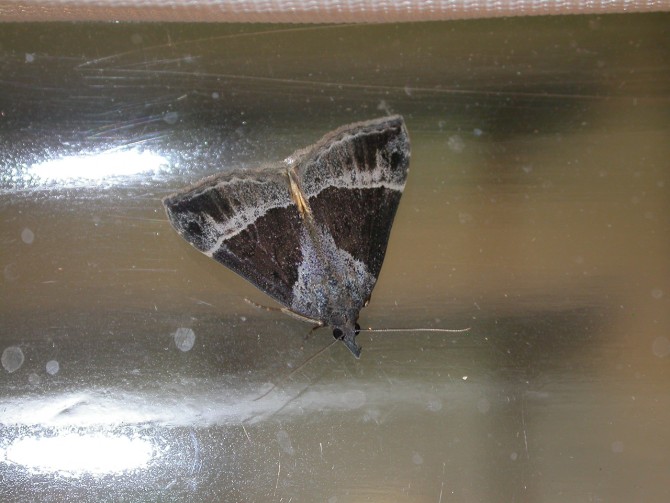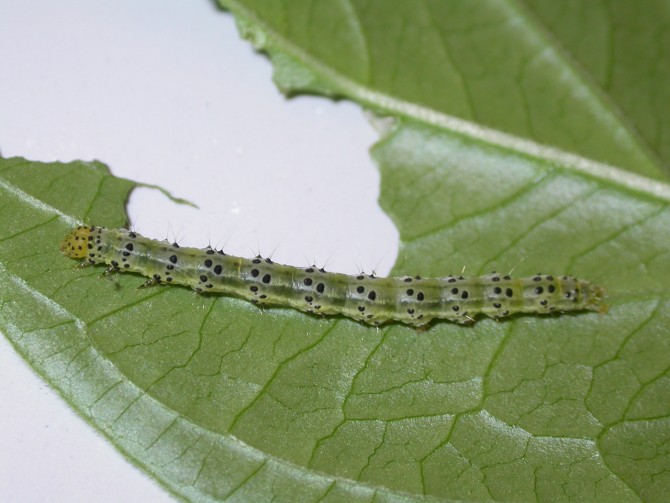Moth provides hope against invasive swallow-wort
By Krishna Ramanujan
Pale and black swallow-wort are rapidly invading fields and forests across the Northeast, including New York, but a moth from the Ukraine holds promise to keep the weed in check.
The larvae of Hypena opulenta feed exclusively on the leaves of pale and black swallow-wort, and after years of research to verify H. opulenta’s safety to ecosystems, the moth was approved for field release by the United States Department of Agriculture in August 2017.
Now, just in time for New York Invasive Species Awareness Week (July 9-14), a team of botanists and entomologists has released the moths into research field cages at Great Gully Nature Preserve in Union Springs, New York, and at the Cornell University Agricultural Experiment Station’s Musgrave Research Farm in Aurora, New York.
In the lab, H. opulenta larvae successfully fed on both pale and black swallow-wort. The field trial will allow the team to study how the larvae survive and establish themselves in natural conditions.
“It’s a lot of work, but once you get the right biological control agent out there, it can be one of the few solutions that is long-term and economical and sustainable,” said Carrie Brown-Lima, M.S. ’02, director of the New York Invasive Species Research Institute, which is housed in the Department of Natural Resources at Cornell’s College of Agriculture and Life Sciences, and is supported by the New York State Department of Environmental Conservation.
Like the moth, pale swallow-wort originates in the Ukraine, while black swallow-wort is native to the Mediterranean region of Europe. Both species were likely introduced to the United States in the 1800s. With no North American natural enemies, these climbing vines threaten plant and animal habitats, including rare plant communities such as New York’s limestone alvar areas on the eastern shore of Lake Ontario. Endangered species like Harts tongue fern found in Clark Reservation State Park near Syracuse are threatened by the vine. They also out-compete milkweed (a native relative of swallow-wort) where monarch butterflies lay their eggs and their larvae feed. When the vines grow in hay fields, they can get mixed with hay and may sicken livestock.
Pale swallow-wort can be dense in areas around the Great Lakes, including Buffalo, Rochester and Jefferson County in New York, and Toronto and Ottawa in Canada. High-density infestations are also found in central New York, the Finger Lakes region and Albany. Black swallow-wort is more abundant on Long Island, along the Hudson River Valley to Albany, and in other New England states, according to Lindsey Milbrath, M.S. ’92, research entomologist at the USDA Agricultural Research Service’s Robert W. Holley Center for Agriculture and Health at Cornell University.
Once H. opulenta had been approved for release, Brown-Lima assembled a team of collaborators that were working independently on different aspects of swallow-wort ecology and control, keeping with the New York Invasive Species Research Institute’smission to connect scientific researchers with on-the-ground managers to address key New York state invasive species issues. The team members are: Milbrath and Jeromy Biazzo, biologist at the Holley Center; Dylan Parry, professor of invasion ecology and entomology at the SUNY College of Environmental Science and Forestry in Syracuse; Andrea Davalos, Ph.D. ’08, assistant professor of conservation biology at SUNY Cortland; Jaclyn Schnurr ’94, professor of biology and environmental science at Wells College; and Lisa Tewksbury, research associate in the Biological Control Lab at the University of Rhode Island in Kingston. The Rhode Island lab currently provides the biocontrol agents for the project.
Later this summer, the team will release more moths into experimental cages at Green Lakes State Park in Fayetteville, New York, and at Robert G. Wehle State Park in Henderson, New York. Additionally, University of Rhode Island collaborators are doing similar caged releases in other Northeastern states.
In addition to the USDA-ARS and NYS DEC, future work will be funded by Smith Lever funds and the New York Department of Transportation.
Media Contact
Get Cornell news delivered right to your inbox.
Subscribe


